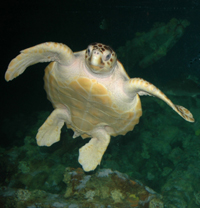Ask an Aquarist
Which sea turtle is the most frequent visitor to North Carolina’s coast?
March 1998
The loggerhead turtle is the most common sea turtle occurring along our coast. More than 99 percent of the nesting sea turtles in North Carolina are loggerheads. These giant turtles are so named because of their massive head and are one of five species of marine turtles that can be found in North Carolina waters. Other less frequent visitors include Kemp’s ridley, hawksbill, green and leatherback turtles.
Like all marine turtles, loggerheads only leave the water to nest. Mating takes place offshore, just beyond the surf, and females come on shore from late spring through early fall to dig nests and lay eggs. Females lumber ashore at night in search of a suitable nest site, typically seeking a spot above the high tide line on an isolated beach. Using their rear flippers, they dig a flask-shaped egg chamber and deposit some 100 leathery-shelled, golf ball-sized eggs before covering the nest and returning to sea. A female usually nests every two to three years, but may lay as many as five clutches of eggs during a nesting year.
Temperatures play a key role in the development of the eggs. Eggs incubated in cooler sand take longer to develop than those in warmer sand. Temperature even determines the sex of turtle hatchlings – eggs in warmer sand produce females and cooler nests produce males.
After a two-month incubation period, the hatchlings break out of their shells and make their way to the sea. These 2-inch turtles face many hazards as they traverse the open beach. Many fall prey to predators such as ghost crabs, gulls and raccoons. Others may become disoriented by the lights of oceanfront developments and head inland, or become trapped by vehicle tracks in the sand as they head for the ocean. Those that do reach the water become food for a variety of fishes. Scientists estimate only one in a thousand hatchlings survive to maturity.

Once in the ocean, hatchlings enter a period known as the “lost years.” Scientists believe the young turtles spend their first years floating in seaweed mats and feed on small invertebrates living in the seaweed. As they grow, their diet changes to larger mollusks and crustaceans.
Loggerheads and other sea turtles have roamed the world’s oceans for more than 150 million years. Today, their survival is threatened. Beachfront development, increased boating and fishing and pollution all contribute to their declining numbers. Scientists currently recognize seven living sea turtle species, all of which are protected by the Endangered Species Act.